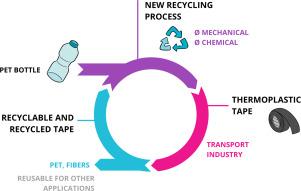Proof of concept for manufacturing of composite tapes with household PolyEthylene Terephthalate (PET) as matrix
IF 5.4
2区 化学
Q2 CHEMISTRY, PHYSICAL
Colloids and Surfaces A: Physicochemical and Engineering Aspects
Pub Date : 2025-09-30
DOI:10.1016/j.colsurfa.2025.138464
引用次数: 0
Abstract
New recycling method for PET is investigated by manufacturing thermoplastic tapes using recycled PolyEthylene Terephthalate (PET) as matrix. PET, which is widely used in the packaging industry, especially for bottles, remains a challenge due to the degradation of its properties during mechanical recycling. Faced with these challenges, a new recycling method for PET is investigated by manufacturing recycled and recyclable thermoplastic tapes using recycled PET as matrix. The process is based on a dissolution-precipitation method inspired by the phase inversion membrane technique. A solubility theory have been used to identify the best solvent/non-solvent combinations.
Experimental results show the efficiency of three solvents: Trifluoroacetic Acid (TFA) , Hexafluoroisopropanol (HFIP) and Gamma-Valerolacone (GVL) combined with water and ethanol as non-solvent and evaporation to dissolve and precipitate PET in the fibrous reinforcement to create the thermoplastic tape. Differential Scanning Calorimetry (DSC), Fourier Transform Infrared Spectroscopy (FTIR) and Scanning Electron Microscopy (SEM) analyses show that the chemical structure of PET has been preserved. SEM images reveal the influence of the choice of solvent/non-solvent combination on porosity and pore distribution in the material.
Proof-of-concept studies carried out with TFA and HFIP suggest that the HFIP/ethanol combination is the most suitable for minimizing degradation and maximizing the matrix content in the fibrous reinforcement. This work therefore lays the foundations for the development of this new recycling method as part of a move towards a circular economy and a reduction in the impact of composite materials, which are difficult to recycle.

以家用聚对苯二甲酸乙二醇酯(PET)为基体制造复合胶带的概念证明
研究了以回收的聚对苯二甲酸乙二醇酯(PET)为基体制备热塑性胶带的PET回收新方法。PET广泛应用于包装行业,特别是瓶子,由于其在机械回收过程中的性能退化,仍然是一个挑战。面对这些挑战,研究了一种新的PET回收方法,即以再生PET为基体,制造可再生和可循环利用的热塑性胶带。该工艺基于受相转化膜技术启发的溶解-沉淀法。溶解度理论被用来确定最佳的溶剂/非溶剂组合。实验结果表明,三氟乙酸(TFA)、六氟异丙醇(HFIP)和γ -戊酸酮(GVL)三种溶剂与水和乙醇作为非溶剂结合,蒸发溶解和沉淀纤维增强中的PET,制备热塑性胶带。差示扫描量热法(DSC)、傅里叶变换红外光谱(FTIR)和扫描电镜(SEM)分析表明,PET的化学结构完好无损。SEM图像显示了溶剂/非溶剂组合的选择对材料孔隙率和孔隙分布的影响。用TFA和HFIP进行的概念验证研究表明,HFIP/乙醇组合最适合最小化降解和最大化纤维增强物中的基体含量。因此,这项工作为开发这种新的回收方法奠定了基础,作为迈向循环经济和减少难以回收的复合材料影响的一部分。
本文章由计算机程序翻译,如有差异,请以英文原文为准。
求助全文
约1分钟内获得全文
求助全文
来源期刊
CiteScore
8.70
自引率
9.60%
发文量
2421
审稿时长
56 days
期刊介绍:
Colloids and Surfaces A: Physicochemical and Engineering Aspects is an international journal devoted to the science underlying applications of colloids and interfacial phenomena.
The journal aims at publishing high quality research papers featuring new materials or new insights into the role of colloid and interface science in (for example) food, energy, minerals processing, pharmaceuticals or the environment.

 求助内容:
求助内容: 应助结果提醒方式:
应助结果提醒方式:


